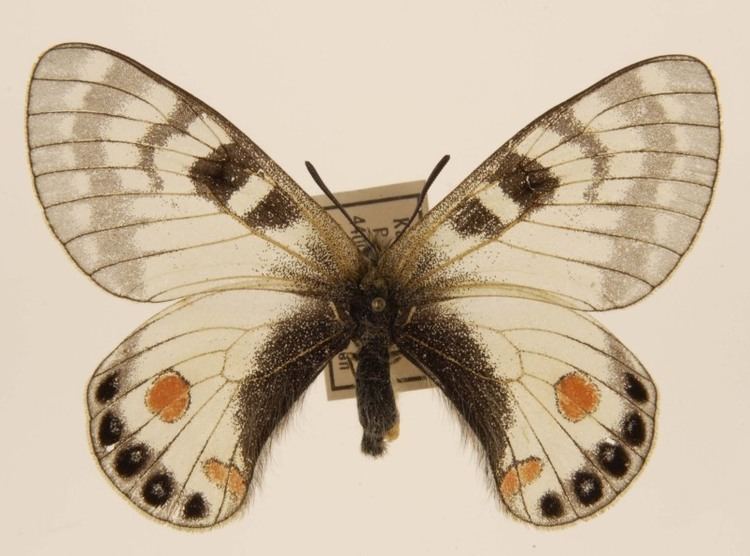Family Papilionidae Scientific name Parnassius stoliczkanus Rank Species | ||
 | ||
Similar Parnassius, Parnassius staudingeri hunza, Parnassius stenosemus, Swallowtail butterfly, Parnassius acdestis | ||
Parnassius stoliczkanus, the Ladakh banded Apollo, is a rare high-altitude butterfly which is found in Central Asia. It is a member of the snow Apollo genus (Parnassius) of the swallowtail family. It is named after the naturalist and explorer Ferdinand Stoliczka.
Contents
Description
Male upperside dull white. Forewing: base and costal margin irrorated with black scales; cell with the usual medial and apical short black transverse bars, the former not extended down to the median vein in typical specimens; discal and postdiscal dusky black sinuate bands, the former attenuated below vein 6, stops short of the dorsum, the latter extends right down to the dorsal margin; beyond these bands the terminal margin is more or less shaded with dusky black which at the tornus coalesces with the postdiscal band. Hindwing: dorsal margin broadly dusky black, this colour narrowed towards the tornus; a postdiscal black-encircled red spot in interspace 5; termen somewhat broadly dusky black, with a subterminal series of darker spots in the interspaces and the dorsal margin fringed with long white hairs. Cilia of both forewings and hindwings white. Underside: like the upperside, the ground colour with the glassy appearance common to all forms in the genus; markings similar, apparent however more by transparency from above than formed by actual scaling. Antennae, head, thorax and abdomen black, the tufted hairs on the head in front fuscous; beneath: the palpi, thorax and abdomen clothed with fuscous hairs.
Female upperside the ground colour differs from that of the 6 in its duller somewhat yellowish tint; the markings are similar but on the hindwing the spots in the subterminal series are centred with blue, the postdiscal red spot is paler, often absent, while in some specimens there is a subtornal red spot. Underside: similar to that of the male. In both sexes the basal red spots on the underside of the hindwing so general in the forms of this genus are usually, if not always, lacking. Antennae, head, thorax and abdomen as in the male. Anal pouch in the fertilized female as in Parnassius hunza.
Range
It ranges from Afghanistan, Pakistan and Kashmir, the northern ranges of India (Himachal Pradesh and Uttarakhand), and China (Tibet).
Subspecies
Status
William Harry Evans said that it was very rare. Further information is needed on this species. The butterfly is protected by law in India.
Identification
The Parnassius species of butterflies are often hard to identify and can sometimes only be identified by dissection of the genitalia. P. R. Ackery (1975) provides a key available online. will key to Parnassius delphius but it is smaller and has better defined markings. The discal band of forewing shortened, in exceptional cases running into the submarginal band. Hindwing with broad marginal band, in which there stand four or five darker spots, which are dusted with blue in the female; as a rule only one ocellus preserved, namely the posterior one, being sometimes reduced to a dot; moreover, often a red hindmarginal dot.
